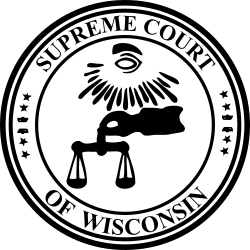Edgerton Bible Case facts for kids
Quick facts for kids Weiss v. District Board |
|
|---|---|

Seal of the Wisconsin Supreme Court
|
|
| Court | Wisconsin Supreme Court |
| Full case name | State ex rel. Weiss et al. v. District Board of School District No. Eight |
| Decided | March 18, 1890 |
| Case history | |
| Appealed from | Wisconsin's 12th circuit |
| Case opinions | |
| Readings from the Bible in public schools constitutes sectarian instruction, in violation of Art. X, Sec. 3, and Art. I, Sec. 18, of the Constitution of Wisconsin | |
| Court membership | |
| Judge(s) sitting |
|
| Case opinions | |
| Decision by | Lyon |
| Concurrence | Cassoday, Orton |
| Dissent | none |
The Edgerton Bible Case (officially called State ex rel. Weiss v. District Board of School District No. Eight) was a very important court case in Wisconsin, a state in the United States. It happened in 1890. This case was all about whether teachers in public schools could read from the King James Bible during class. The court decided that this practice was against the law because it mixed government and religion too much.
Contents
Why the Edgerton Bible Case Happened
In the late 1800s, it was common for teachers in public schools in places like Edgerton, Wisconsin, to read aloud from the King James Bible. This was a regular part of the school day.
However, in 1886, some parents who were Roman Catholic disagreed with this practice. They believed that the Douay Bible was the correct version for their children. They felt that reading from the King James Bible was not fair to their religious beliefs.
Taking the Case to Court
The parents tried to convince the school board to stop the Bible readings, but they were not successful. So, a group of parents, including Frederick Weiss, decided to take their concerns to court.
In November 1888, a local judge named John R. Bennett looked at the case. He decided that the Bible readings were okay. He thought that both the King James Bible and the Douay Bible were similar enough, so the readings were not favoring one religion over another.
The parents did not agree with this decision. They then appealed their case to the highest court in the state, the Wisconsin Supreme Court.
The Supreme Court's Decision
The Wisconsin Supreme Court heard the case, which became known as the Edgerton Bible Case. In March 1890, the judges of the Supreme Court disagreed with the lower court's decision. They ruled that reading the Bible in public schools was against the law.
The court said that this practice illegally joined the jobs of the church and the government. In the United States, the government and religious groups are supposed to be separate. This means public schools, which are run by the government, should not promote or favor any specific religion.
Lasting Impact of the Case
The Edgerton Bible Case was an important step in keeping government and religion separate in schools. Many years later, in 1963, the United States Supreme Court made a similar decision. In a case called Abington School District v. Schempp, the U.S. Supreme Court banned government-sponsored required prayer in public schools. One of the judges in that case, Justice William Brennan Jr., even mentioned the Edgerton Bible Case in his decision.

